雅思阅读八大题型
雅思阅读8大阅读题型介绍
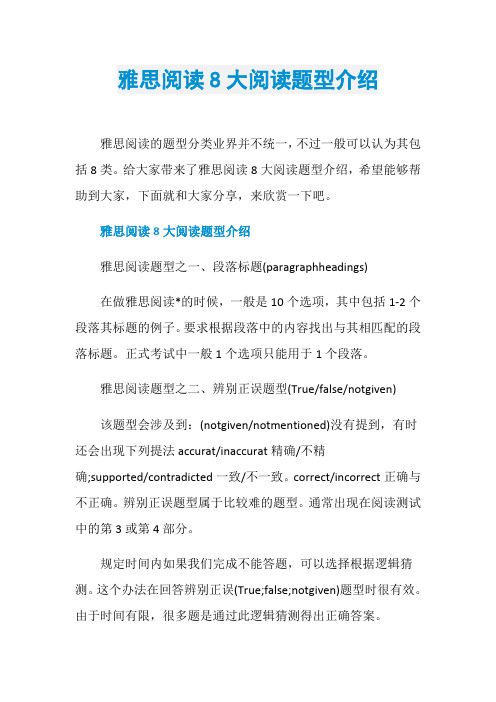
雅思阅读8大阅读题型介绍雅思阅读的题型分类业界并不统一,不过一般可以认为其包括8类。
给大家带来了雅思阅读8大阅读题型介绍,希望能够帮助到大家,下面就和大家分享,来欣赏一下吧。
雅思阅读8大阅读题型介绍雅思阅读题型之一、段落标题(paragraphheadings)在做雅思阅读*的时候,一般是10个选项,其中包括1-2个段落其标题的例子。
要求根据段落中的内容找出与其相匹配的段落标题。
正式考试中一般1个选项只能用于1个段落。
雅思阅读题型之二、辨别正误题型(True/false/notgiven)该题型会涉及到:(notgiven/notmentioned)没有提到,有时还会出现下列提法accurat/inaccurat精确/不精确;supported/contradicted一致/不一致。
correct/incorrect正确与不正确。
辨别正误题型属于比较难的题型。
通常出现在阅读测试中的第3或第4部分。
规定时间内如果我们完成不能答题,可以选择根据逻辑猜测。
这个办法在回答辨别正误(True;false;notgiven)题型时很有效。
由于时间有限,很多题是通过此逻辑猜测得出正确答案。
雅思阅读题型之三、回答问题(short-answerquestiontasks)回答问题是根据所给*或图表回答问题。
雅思阅读考试中中通常是出现what、which、when、where、who、whose、whom、why、how等单词。
这些单词有时会在答题指引中将所提问题列出。
回答问题答题步骤:1.仔细查看答题指引,了解回答何种问题。
2.查看例句,确定答题方式。
3.要确定问句的种类,一般疑问句可按正常形式回答,如果是选择疑问句或者是以wh/how开头的问句就一定要具体回答。
4.仔细理解问句所提问题。
5.特别要注意问句中所提问题的关键词语(例如:单数、复数),以及问句中表明数量、时间、地点的词语。
6.将问句中的关键词语与*中相关句子中的词语进行匹配。
雅思阅读八大题型之填空题

环球雅思老师为你解读雅思阅读八大题型之判断题雅思阅读主要有以下八大题型:判断题(TURE/FALSE/NOT GIVEN),填空题(SUMMARY),段落标题配对题(LIST OF HEADINGS),配对题(MA TCHING),选择题(MUTILPCHIOCE),填空题(COMPLETION),简答题(SHORT ANSWER)和图表题(TABLE)。
其中前四类题型是雅思阅读的必考题型。
本文主要分析填空题(SUMMARY)的读题和解题技巧。
一、填空题的读题与解题⑴填空题主要分为两类:目前归纳题有两种趋势,一种是题目贯穿在整篇文章,另一种是只隐藏在其中一二个段落。
前者下文称为“有备选项”,后者下文称为“无备选项”。
①“有备选项”的填空题特征:题干内容分布在原文多个段落中,比较零散,找题难度较大;要求考生找出原文原词后,从备选项表格中找出跟原文原词同义置换的选项,解题难度较大。
②“无备选项”的填空题特征:题干内容分布在原文2-3段中,因此要求考生准确定位题干在原文中的出处,然后主意要填写原文原词即可。
⑵读题“四步走”。
①第一步:精读填空题题干的首段首句。
无论有备选项还是无备选项,首句一般不设空,因此通过划找首句的关键词,能够帮助考生会原文准确定位出题方位,避免时间的浪费。
通常,可以作为关键词回原文定位的包括:人名、地名、机构、时间、年代、数字、专有名词。
②第二步:处理第一个空格如果首句模糊或首句设有空格,就要按照以下2步来处理第一个空格:第一,根据空格前后内容初步判断空格词性。
一般填空题的题干词性都是名词、动词、形容词和副词,以前三者为主。
第二,划找“空前空后词”,这里所谓的“空前空后词”不是实际意义上的空前空后词,而是那些能够提示空格内容的词组和结构。
③第三步:继续处理其余空格填空题的出题顺序也是按照原文行文顺序来的,考生按照处理第一个空格的方式继续处理其余空格即可。
即便有逆向出题或是乱序,也是少数,而且也只会是两个近似空格的乱序。
雅思阅读题型分布

雅思阅读题型分布
雅思阅读题型分布通常包括以下几种类型:
1. True/False/Not Given(判断题):根据文章内容判断给出的
陈述是否属实。
2. Multiple Choice(选择题):根据文章内容选择正确的答案。
3. Matching(配对题):根据文章内容将一组相互对应的信息
进行配对。
4. Sentence Completion(句子填空题):根据文章内容将所给
句子中的空位填上正确的信息。
5. Summary Completion(摘要填空题):根据文章内容将所给
摘要中的空位填上正确的信息。
6. Note Completion(笔记填空题):根据文章内容将所给笔记中的空位填上正确的信息。
7. Short Answer Questions(简答题):根据文章内容回答问题。
8. Diagram Labeling(图表标注题):根据文章内容标注图表
中的部分或给出描述的信息。
9. Yes/No/Not Given(判断题):根据文章内容判断给出的陈
述是否属实。
以上是雅思阅读中常见的题型,考生在备考期间应该熟悉各个题型的特点和解题技巧,并进行针对性的练习。
雅思阅读题型
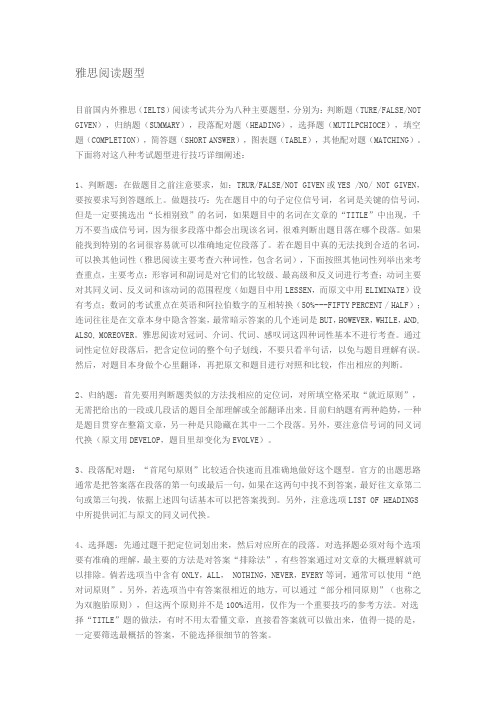
雅思阅读题型目前国内外雅思(IELTS)阅读考试共分为八种主要题型,分别为:判断题(TURE/FALSE/NOT GIVEN),归纳题(SUMMARY),段落配对题(HEADING),选择题(MUTILPCHIOCE),填空题(COMPLETION),简答题(SHORT ANSWER),图表题(TABLE),其他配对题(MATCHING)。
下面将对这八种考试题型进行技巧详细阐述:1、判断题:在做题目之前注意要求,如:TRUR/FALSE/NOT GIVEN或YES /NO/ NOT GIVEN,要按要求写到答题纸上。
做题技巧:先在题目中的句子定位信号词,名词是关键的信号词,但是一定要挑选出“长相别致”的名词,如果题目中的名词在文章的“TITLE”中出现,千万不要当成信号词,因为很多段落中都会出现该名词,很难判断出题目落在哪个段落。
如果能找到特别的名词很容易就可以准确地定位段落了。
若在题目中真的无法找到合适的名词,可以换其他词性(雅思阅读主要考查六种词性,包含名词),下面按照其他词性列举出来考查重点,主要考点:形容词和副词是对它们的比较级、最高级和反义词进行考查;动词主要对其同义词、反义词和该动词的范围程度(如题目中用LESSEN,而原文中用ELIMINATE)设有考点;数词的考试重点在英语和阿拉伯数字的互相转换(50%---FIFTY PERCENT / HALF);连词往往是在文章本身中隐含答案,最常暗示答案的几个连词是BUT,HOWEVER,WHILE,AND, ALSO, MOREOVER。
雅思阅读对冠词、介词、代词、感叹词这四种词性基本不进行考查。
通过词性定位好段落后,把含定位词的整个句子划线,不要只看半句话,以免与题目理解有误。
然后,对题目本身做个心里翻译,再把原文和题目进行对照和比较,作出相应的判断。
2、归纳题:首先要用判断题类似的方法找相应的定位词,对所填空格采取“就近原则”,无需把给出的一段或几段话的题目全部理解或全部翻译出来。
雅思考试阅读部分的8种类型题应答全攻略

雅思考试阅读部分的8种类型题应答全攻略
一、paragraph headings(段落标题)最频繁的题型之一
在阅读文章的后面给出list of headings,一般是10个左右选项,其中含一到两个段落及其标题的例子。
要求对题目中给出的段落,根据其内容找出与其相匹配的段落标题。
尽管题目说明中提示一个选项可能会适用多个,但正式考试中一般一个选项只能用于一个段落。
段落标题类答题步骤:
1. 首先在list of headings中划去做为例子的heading 或headings,以免在根据段落内容在list of headings中找出与其相匹配的段落标题时,它(它们)会干扰考试者对其他headings的选择。
2. 在文章中把做为例子的段落划掉,以免对例子段落进行不必要的精读。
3. 对题目中给出的段落,按照首句(第一、二句)、末句和中间句寻找主题句的方法,在list of headings中找出与其相匹配的段落标题。
4. 如果时间允许,按照文章的段落顺序,对非题目中给出的段落及。
雅思阅读8大题型的解题技巧

雅思阅读8大题型的解题技巧雅思阅读对于许多中国考生来说,也是一个不好“跨越”的学科,今日我给大家带来了雅思阅读8大题型的解题技巧,盼望能够关心到大家,下面我就和大家共享,来观赏一下。
雅思阅读8大题型的解题技巧1、推断题在雅思阅读考试的推断题中,肯定要留意要求。
比如:TRUR/FALSE/NOT GIVEN或YES /NO/ NOT GIVEN,要按要求写到答题纸上。
小站老师技巧:在做题的时候,现在题目中找到定位词和信号词,一般要留意名词。
假如在题目中真的无法找到合适的名词,可以换其他词性(雅思阅读主要考查六种词性,包含名词)。
留意:最常示意答案的几个连词是BUT,HOWEVER,WHILE,AND, ALSO, MOREOVER。
2、归纳题在雅思阅读的归纳题中,首先要用推断题的方法找到相应的定位词,目前归纳题有两种趋势,一种是题目贯穿在整篇文章,另一种是只隐蔽在其中一二个段落。
3、配对题配对题相对来说比较好做,一般“首尾句原则”就比较适合这种题型。
4、选择题做雅思阅读选择题的时候,要留意通过提干把关键词和定位词划出来,然后对应所在的熬炼就可以。
5、填空题在雅思阅读考试中,填空题的做法和归纳题差不多,都是先找定位词找出正确的段落,然后通过“就近原则”填空。
6、简答题做雅思阅读简答题,首先要看清题目要求“NO MORE THAN -WORDS”,肯定要留意题目的字数限制。
7、图表题在雅思阅读考试中,图表题的形式和要求相对来说比较严格,在实际做题中,首先要留意“序号”原则,其次要留意“形式全都原则”。
8、其它配对题这类题型的干扰力量较大,“隐藏性”也较大,考生要特殊留意,另外,与HEADING题不同的是它们的答案通常不是在句首或句尾,而是在段落当中的某几句话,应当利用信号词“快速扫描法”进行定位段落,然后进行分析。
基本方法剖析雅思阅读简单难句IELTS的阅读部分有大量句型结构简单、难以理解和把握的简单句或难句。
雅思阅读八大题型

雅思阅读讲义必考的高频替换第一章基础知识IELTS:International English Language Testing System ACADEMIC READING:1.23.第二章雅思阅读八大题型第一节标题对应题(list of headings)三.判断依据:1.绝大部分的段落的主题句位于段落句首。
2.段落次句作为主题句的情况大约是20%左右,认定段落次句是主题句的三个依据:a.当首句是疑问句的时候,而且疑问句通常是设问型,属于自问自答的形式,因此其后的次句容才是真正的段落主题句。
b.首段是过渡句时,次句也是主题句,判断是过渡句的标准如下:一.若段落首句容与上段主题句容重合,可认定首句是过度句。
二.若段落首句中含有not only,not simply,besides和beyond等表达。
“不仅....”“除了....还有...”词汇是也可以基本认定,该句是过渡句,见到这些标志词就直接读次句。
三.段落次句与首句形成转折时,也需要关注。
标志词:although,but,however,while,yet,despite,even though,on the contrary,nevertheless,nonetheless.3.段落末句是主题句的情况比较少,而且只有遇到“主题选择题”的题型时,才有可能将段落末句作为段落主题句,通常会用代词指代上下文容,标志词有:this,these,they,it等。
四.注意事项:1. 认真阅读标题选择题中的已经给定的例题答案,因为__________2. 有选择的时候一定要采用的就是“较优原则”,而不是“最恰当”选项。
此类题目选中的选项意思不一定就是段落大意,有时候只是原文段落中的某个细节。
3. 有选项就一定能用排除的方法。
4. 如果答案不确定,先将可能正确的选项全部选出。
5. 干扰选项的特点是:是细节而非主旨。
6. 越是和原文细节一致的选项,越应该排除掉,正确答案应是主题句的改写,与主题句特别一致的选项一般引起怀疑。
雅思阅读八大题型之判断题解答

雅思阅读主要有以下八大题型:判断题(TURE/FALSE/NOT GIVEN),归纳题(SUMMARY),段落标题配对题(LIST OF HEADINGS),配对题(MATCHING),选择题(MUTILPCHIOCE),填空题(COMPLETION),简答题(SHORT ANSWER)和图表题(TABLE)。
其中前四类题型是雅思阅读的必考题型。
这四类题型对于多数考生来说可谓是四大名“不”——读不懂题、找不到文中出处、得不出答案、时间不够。
在时间紧迫的情况下,多数考生往往匆匆浏览完题干后就进入正文阅读了,但这会造成一个巨大隐患——由于潦草读题导致把握不住原文的阅读重心,解题时往往重复阅读原文,大大浪费了宝贵的时间。
所以广大考生们一定要扭转思路——读题比解题更重要!题干读懂读到位了,就是在为你的阅读和解题节省时间、提高准确率。
本文主要从判断题(TURE/FALSE/NOT GIVEN)的读题和解题技巧出发,为解决考生们的四大名“不”困扰给出思路。
对于判断题,让大多数考生十分困惑的就是FALSE和NOT GIVEN之间的区别。
以下试看一例:原文:Sydney harbor is one of the largest in the world.题干:Sydney harbor is the largest in the world.有同学就说:我知道,世界上最大的港口是Holland的Rotterdam,而不是悉尼港,因此这道题是FALSE。
但是雅思阅读的判断题是语言类的考试,不是常识考试,判断一道题到底是TRUE,FALSE还是NOT GIVEN要从这三点基本原则出发,即原文和题干之间是一致性则为TRUE,矛盾性则为FALSE,不确定性则为NOT GIVEN。
比如上文的原文说悉尼港是世界第一大港口之一,那么有可能悉尼港是第一大,也有可能是第二大,因此题干的表述“悉尼港是世界第一大港口”就是不确定的,因此为NOT GIVEN。
雅思考试阅读有哪些题型

雅思考试阅读有哪些题型一些预备雅思阅读的同学表示,只有多做题才能提高雅思索试阅读部分的成果,所以他们陷入了战术的海洋。
今日我给大家带来雅思索试阅读有哪些题型,盼望能够关心到大家,下面我就和大家共享,来观赏一下吧。
雅思索试阅读有哪些题型雅思阅读题型一、主旨类1.标题对应(List of headings)2.标题(Best title)3.概述题(Summary)雅思索试阅读题型二、细节类1.推断题(TRUE / FALSE / NOT GIVEN )2.配对题(Matching)3.填空题(sentence completion)4.简答题(Short-answer questions)5.图表题(Table/Flow chart/Diagram)6.选择题(Multiple choice)阅读考试小贴士:• 需要仔细的阅读题目的指示与说明,这些信息通常会告知大家在何处查找答案、你需要做什么、要怎么回答问题,还有答案字数的限定。
在题目的指示依旧会表示答案是否可以多次使用,并提示你把答案转抄到答卷上。
• 要留意大部分的题型下,题目消失的挨次与信息在文章里会有相同的消失挨次。
•留意仔细与更全地阅读题目要求。
• 进行扫读练习,以便能在文章片段中快速查找与题目相关的关键词。
大家同样能够使用扫读练习在段落中查找关键词。
• 在大多数状况下(如填空题),你所填写的答案需符合正确的语法要求,答案的拼写就是正确的。
正确的单词拼写和词组搭配是特别重要的,消失错误是要被扣分的。
• 在大多数状况下,考生们能够在文章中把需要填写的单词找到,同时还要把这个词仔细的抄在答卷上。
假如消失拼写错误是要被扣分的。
• 当把句子完成的题目中,需要的是更留意理解句子的意思,同时通过这样来选择正确的答案。
• 运用笔记、表格、图表亦或是流程图里的内容与范例来猜测答案所涉及的信息的类型。
雅思阅读推断题解题技巧指导雅思阅读推断题解题技巧有哪些?关于雅思阅读推断题,其实在雅思阅读当中算是比较简洁的一部分,由于雅思阅读推断题都是根据原文内容挨次出的。
雅思阅读考题类型及解题技巧汇总

雅思阅读考题类型及解题技巧汇总雅思阅读考试时间一共是60分钟,考生需要在此期间完成3篇文章的阅读及回答40道题目。
其中40道题目中,题型各有不同。
店铺总结了在雅思阅读题目中,常见的八种题型,具体如下。
雅思阅读考题类型及解题技巧汇总1.填空题2.选择题3.配对题4.真假题5.完成句子题6.图解标签题7.短问答8.图表完成题对于不同的文章,同学们最好采取不同的应对方式,以提高答题效率及答题准确性。
在此,小站教育就先给大家来讲一讲雅思阅读中的填充题及选择题的解题技巧,正在备考的同学们快快看过来吧。
详解雅思阅读考试填空题通常来说,在雅思阅读考试中的填空题大多是遵循顺序原则,只有极为少数的情况下是前后两个题目顺序打乱了的。
如果填空题出现在一篇文章后的第一个题目,那么往往是考察全篇的题目;以此类推,当填空题出现在文章后面的中间题型,那么对应文章段落也应该为中间部分;当然如果填空题出现在文章最后一个题型,基本上就是对应文章中后部分以及文章最后的段落。
所谓知己知彼,百战不殆。
同学们如果对题型特点有了一个深入的了解后,那么就能有助于同学们更好地把握整篇文章及进行精确定位。
对题型特点有了一个了解之后,再从从题目入手。
小站教育建议大家首先观察题目中围绕空格前后是否有表示句子关系的词,例如表示转折关系的but, 因果关系because, as a result of, 并列关系and, 举例关系for example, such as以及时间关系before等。
所谓细节决定成败,把握这些小细节往往是做题的关键。
即便来说这些关系词在原文中是用其他词做了替换了,但关系依然存在。
怎样对空格里的词进行定位。
小站教育建议大家依据顺序原则,在空格前后划出特殊定位词,以此来帮助定位。
如果说没有特殊定位词,就找相对特殊的名词或者动词来依顺序进行定位。
详解雅思阅读选择题出题方式1.改写原则:出题关键字基本都是对文章内容的改写;2.顺序原则:文中题目基本上按照文章顺序排列;3.首尾原则:大约50%的题目分布在文章首尾句以及首尾段;4.名词原则:出题关键字基本都以名词作为考点;5.数字原则:会出现一些带有简单运算最难不超过四则运算的简答题;6.下定义原则:破折号,同位语从句,定语从句有可能处提;7.特殊符号,特殊字体原则:括号(),引号“”,黑体,斜体,下划线,以及比较罕见的词汇有可能出题;8.图表原则:如果文章中有图表则要留心图表部分会出题。
雅思阅读8种题型
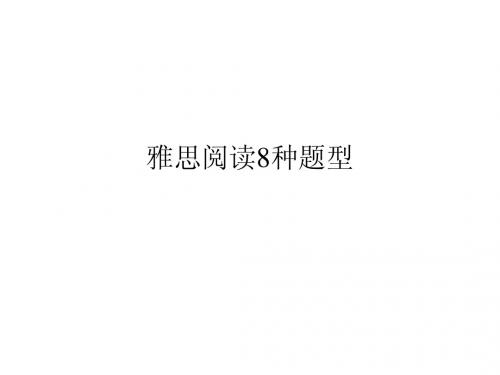
•
回答问题答题步骤: 1. 仔细查看答题指引,了解回答何种问题。 2. 查看例句,确定答题方式。
3. 要确定问句的种类,一般疑问句可按正常形式回答(例如:yes/no),如果是 选择疑问句或者是以wh/how开头的问句就一定要具体回答
4. 仔细理解问句所提问题。 5. 特别要注意问句中所提问题的关键词语(例如:单数、复数),以及问句中 表明数量、时间、地点的词语。 6. 将问句中的关键词语与文章中相关句子中的词语进行匹配。 7. 确定问句与文章中相关句子含义是否一致,得出答案。
• 配对题答题步骤: 1. 仔细查看答题指引,了解回答何种问题。 2. 查看例句,确定答题方式。
3. 弄清那些选项是同义选项,那些选项是反义选 项,那些选项是有关数字选项。
4. 根据在题目中自己划出的中心词在原文中寻找 信息点,注意以大写、斜体、括号和引号方式出现的 概念。 5. 对于有关人名与理论、新产品和发明家、时间 的配对题,首先要快速找出人名、公司名和时间,然 后在附近的上下文中找答案。
8. 填空所需词性如果为名词,而单词表中并无名 词,仅有形容词,就必须将该形容词转换成名词形式 进行填空,但这种情况并不多见。
•
七、完成句子题型 (sentence completion tasks) 完成句子题型就是先给出句子的一部分, 未给出部分在文章中找出,或者给出2-3个答案, 由你选择一个。这种题型较难,要花一点时间 仔细查看文章中的有关部分。
• 完成句子题答题步骤:
1. 详细阅读答题指引,获取必要的答题信息。
2. 参考例句,确定答题形式。 3. 利用语法知识确定句子缺失部分。
4. 仔细查看所给句子的含义,并找出关键词语。
5 利用所给部分的关键词语在文章中找出相关句子。 6. 在文章中的相关句子里,选取缺失部分(即答案)。 如果完成句子题型是以多重选择的形式出现,那么则要将选 择答案部分列为问句的一部分,从中选取所需的关键词语,逐个 与文章中相关句子进行匹配。
雅思a类阅读8种主要题型技巧总结

雅思a类阅读8种主要题型技巧总结雅思考试的阅读部分是很多考生的短板,其中A类题型涉及范围比较广,需要考生在短时间内做出正确的选择。
下面是8种主要题型的技巧总结:1. 主旨题主旨题是针对文章主要思想的问题,考生需要准确理解文章的重点和主旨。
通常主旨题会出现在文章的开头或结尾,或是通过多次提及来暗示主题。
2. 细节题细节题是考察考生对文章中细节信息的捕捉能力,通常考生需要在文章中找到具体的词语、数字或日期等细节信息,然后将其填入题目空格中。
3. 推断题推断题是考察考生对文章意义和文章中隐含信息的理解能力,需要结合文章上下文来推断答案。
通常考生需要运用逻辑推理能力来解答此类题目。
4. 对比题对比题是考察考生对文章中两个或多个事物之间相同和不同之处的辨析能力。
考生需要准确找出文章中的比较对象,并对它们进行对比分析。
5. 事实题事实题是考察考生对文章事实信息的理解能力,通常问题的答案可以在文章中直接找到。
考生需要注意细节信息,准确找出文中的事实细节,然后进行选择题。
6. 句意题句意题是考察考生对文章中句子意思的理解能力,通常需要考生通过上下文来推断句子的意思。
考生需要注意文章中的语法结构和修辞手法,来理解句子的真正含义。
7. 排序题排序题是考察考生对文章中事件发生顺序的理解能力,通常需要考生通过细节信息分析出故事情节,并将其排序。
考生需要注意故事中的时间和顺序关系,准确排序。
8. 否定题否定题是考察考生对文章信息的准确性判断能力,通常需要考生通过对文章内容进行分析,找出错误或不真实的信息。
考生需要仔细阅读文章,准确找出不符合事实的信息,进行排除。
以上是雅思A类阅读8种主要题型的技巧总结,希望可以对考生们在备考中有所帮助。
雅思阅读题型汇总分类精选全文完整版
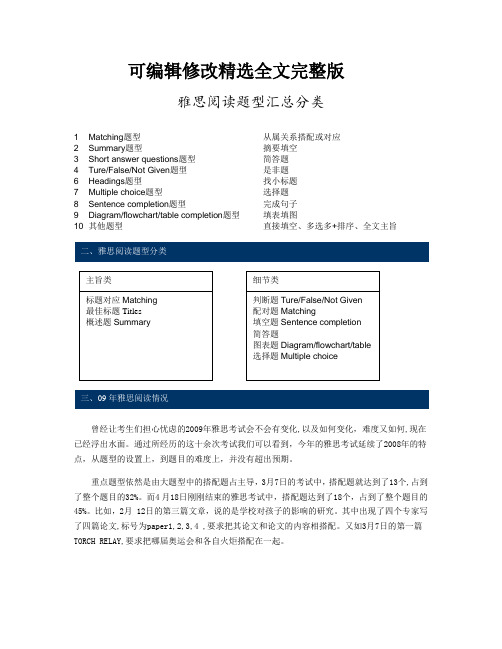
可编辑修改精选全文完整版雅思阅读题型汇总分类1 Matching题型从属关系搭配或对应2 Summary题型摘要填空3 Short answer questions题型简答题4 Ture/False/Not Given题型是非题6 Headings题型找小标题7 Multiple choice题型选择题8 Sentence completion题型完成句子9 Diagram/flowchart/table completion题型填表填图10 其他题型直接填空、多选多+排序、全文主旨三、09年雅思阅读情况曾经让考生们担心忧虑的2009年雅思考试会不会有变化,以及如何变化,难度又如何,现在已经浮出水面。
通过所经历的这十余次考试我们可以看到,今年的雅思考试延续了2008年的特点,从题型的设置上,到题目的难度上,并没有超出预期。
重点题型依然是由大题型中的搭配题占主导,3月7日的考试中,搭配题就达到了13个,占到了整个题目的32%。
而4 月18日刚刚结束的雅思考试中,搭配题达到了18个,占到了整个题目的45%。
比如,2月 12日的第三篇文章,说的是学校对孩子的影响的研究。
其中出现了四个专家写了四篇论文,标号为paper1,2,3,4 ,要求把其论文和论文的内容相搭配。
又如3月7日的第一篇TORCH RELAY,要求把哪届奥运会和各自火炬搭配在一起。
题型概述及解题思路3 Short answer questions题型简答题1.题型要求每个题目都是一个特殊问句,要求根据原文作出回答。
绝大部分的题目要求有字数限制,一般有如下几种表达方式:(1)NO MORE THAN TWO/THREE/FOUR WORDS(不超过2/3/4个字);(2)ONE OR TWO WORDS(一个或两个字);(3)Use a maximum of TWO words(最多两个字)。
有字数限制的,一定要严格按照题目要求去做。
少部分的题目要求中没有字数限制,这时,请注意,答案字数也不会很长,一般不会超过四个字。
雅思a类阅读8种主要题型技巧总结
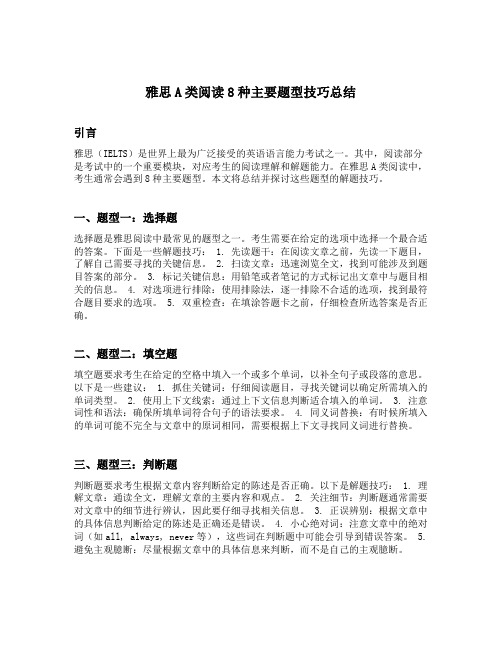
雅思A类阅读8种主要题型技巧总结引言雅思(IELTS)是世界上最为广泛接受的英语语言能力考试之一。
其中,阅读部分是考试中的一个重要模块,对应考生的阅读理解和解题能力。
在雅思A类阅读中,考生通常会遇到8种主要题型。
本文将总结并探讨这些题型的解题技巧。
一、题型一:选择题选择题是雅思阅读中最常见的题型之一。
考生需要在给定的选项中选择一个最合适的答案。
下面是一些解题技巧: 1. 先读题干:在阅读文章之前,先读一下题目,了解自己需要寻找的关键信息。
2. 扫读文章:迅速浏览全文,找到可能涉及到题目答案的部分。
3. 标记关键信息:用铅笔或者笔记的方式标记出文章中与题目相关的信息。
4. 对选项进行排除:使用排除法,逐一排除不合适的选项,找到最符合题目要求的选项。
5. 双重检查:在填涂答题卡之前,仔细检查所选答案是否正确。
二、题型二:填空题填空题要求考生在给定的空格中填入一个或多个单词,以补全句子或段落的意思。
以下是一些建议: 1. 抓住关键词:仔细阅读题目,寻找关键词以确定所需填入的单词类型。
2. 使用上下文线索:通过上下文信息判断适合填入的单词。
3. 注意词性和语法:确保所填单词符合句子的语法要求。
4. 同义词替换:有时候所填入的单词可能不完全与文章中的原词相同,需要根据上下文寻找同义词进行替换。
三、题型三:判断题判断题要求考生根据文章内容判断给定的陈述是否正确。
以下是解题技巧: 1. 理解文章:通读全文,理解文章的主要内容和观点。
2. 关注细节:判断题通常需要对文章中的细节进行辨认,因此要仔细寻找相关信息。
3. 正误辨别:根据文章中的具体信息判断给定的陈述是正确还是错误。
4. 小心绝对词:注意文章中的绝对词(如all, always, never等),这些词在判断题中可能会引导到错误答案。
5. 避免主观臆断:尽量根据文章中的具体信息来判断,而不是自己的主观臆断。
四、题型四:匹配题匹配题要求考生将一系列问题或陈述与给定的选项进行匹配。
雅思所有阅读题目一览

雅思所有阅读题目一览
雅思阅读部分涵盖了多个主题和题型。
以下是一些常见的雅思阅读题目类型的一览:
1. 判断题:根据文章内容判断陈述是否正确、错误或无法判断。
2. 填空题:根据文章内容,在空白处填入适当的单词、短语或数字。
3. 多选题:从给出的选项中选择多个答案,以回答问题或完成陈述。
4. 段落匹配题:将给出的段落与文章中的相应段落进行匹配。
5. 标题配对题:将给出的标题与文章中的相应段落进行匹配。
6. 选择题:从给出的选项中选择一个最佳答案,以回答问题或完成陈述。
7. 判断正误与未提及:判断给出的陈述是正确、错误还是在文章中未提及。
8. 流程图/图表填空题:根据所给流程图或图表,在空白处填
写适当的单词。
9. 摘要填空题:根据文章内容,在给定的摘要中选择适当的句子填空。
10. 同义词配对题:将给出的同义词与文章中的相应词进行匹配。
以上是一些常见的雅思阅读题目类型,考生需要熟悉这些题型,并针对每一种题目类型进行有针对性的准备。
雅思阅读八大题型详解
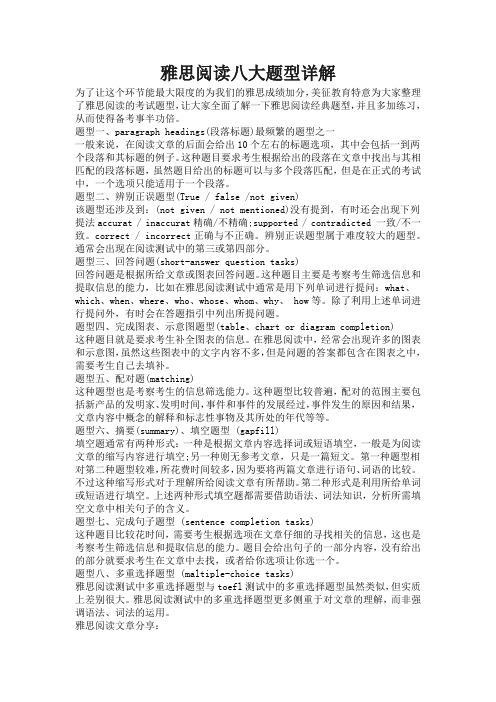
雅思阅读八大题型详解为了让这个环节能最大限度的为我们的雅思成绩加分,美征教育特意为大家整理了雅思阅读的考试题型,让大家全面了解一下雅思阅读经典题型,并且多加练习,从而使得备考事半功倍。
题型一、paragraph headings(段落标题)最频繁的题型之一一般来说,在阅读文章的后面会给出10个左右的标题选项,其中会包括一到两个段落和其标题的例子。
这种题目要求考生根据给出的段落在文章中找出与其相匹配的段落标题,虽然题目给出的标题可以与多个段落匹配,但是在正式的考试中,一个选项只能适用于一个段落。
题型二、辨别正误题型(True / false /not given)该题型还涉及到:(not given / not mentioned)没有提到,有时还会出现下列提法accurat / inaccurat精确/不精确;supported / contradicted 一致/不一致。
correct / incorrect正确与不正确。
辨别正误题型属于难度较大的题型。
通常会出现在阅读测试中的第三或第四部分。
题型三、回答问题(short-answer question tasks)回答问题是根据所给文章或图表回答问题。
这种题目主要是考察考生筛选信息和提取信息的能力,比如在雅思阅读测试中通常是用下列单词进行提问:what、which、when、where、who、whose、whom、why、 how等。
除了利用上述单词进行提问外,有时会在答题指引中列出所提问题。
题型四、完成图表、示意图题型(table、chart or diagram completion)这种题目就是要求考生补全图表的信息。
在雅思阅读中,经常会出现许多的图表和示意图,虽然这些图表中的文字内容不多,但是问题的答案都包含在图表之中,需要考生自己去填补。
题型五、配对题(matching)这种题型也是考察考生的信息筛选能力。
这种题型比较普遍,配对的范围主要包括新产品的发明家、发明时间,事件和事件的发展经过,事件发生的原因和结果,文章内容中概念的解释和标志性事物及其所处的年代等等。
雅思阅读各题型介绍
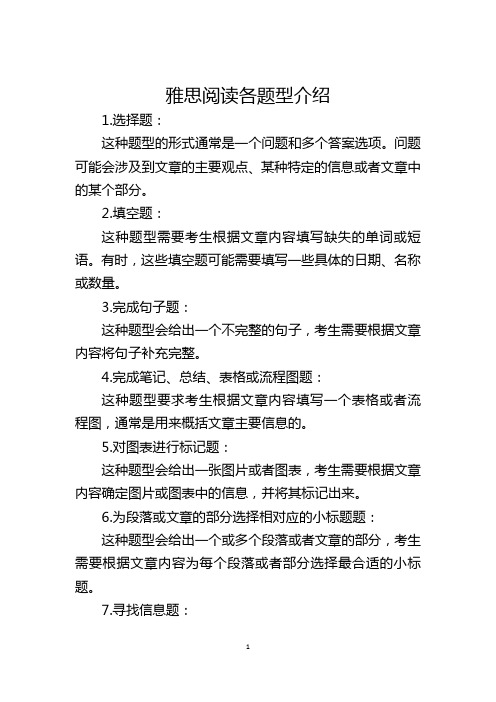
雅思阅读各题型介绍
1.选择题:
这种题型的形式通常是一个问题和多个答案选项。
问题可能会涉及到文章的主要观点、某种特定的信息或者文章中的某个部分。
2.填空题:
这种题型需要考生根据文章内容填写缺失的单词或短语。
有时,这些填空题可能需要填写一些具体的日期、名称或数量。
3.完成句子题:
这种题型会给出一个不完整的句子,考生需要根据文章内容将句子补充完整。
4.完成笔记、总结、表格或流程图题:
这种题型要求考生根据文章内容填写一个表格或者流程图,通常是用来概括文章主要信息的。
5.对图表进行标记题:
这种题型会给出一张图片或者图表,考生需要根据文章内容确定图片或图表中的信息,并将其标记出来。
6.为段落或文章的部分选择相对应的小标题题:
这种题型会给出一个或多个段落或者文章的部分,考生需要根据文章内容为每个段落或者部分选择最合适的小标题。
7.寻找信息题:
这种题型需要考生根据问题寻找文章中特定的信息。
8.寻找作者观点、论点或文章中的具体信息题:
这种题型需要考生找到作者的观点、论点或者文章中的具体信息。
9.分类题:
这种题型要求考生根据文章内容将一些项目分类。
10.配对题:
这种题型需要考生将一些项目与文章中的内容进行匹配。
以上是雅思阅读考试的十大题型。
每种题型的难度和形式都不尽相同,因此考生需要根据不同题型的特点和要求,采取相应的策略和技巧进行应对。
- 1、下载文档前请自行甄别文档内容的完整性,平台不提供额外的编辑、内容补充、找答案等附加服务。
- 2、"仅部分预览"的文档,不可在线预览部分如存在完整性等问题,可反馈申请退款(可完整预览的文档不适用该条件!)。
- 3、如文档侵犯您的权益,请联系客服反馈,我们会尽快为您处理(人工客服工作时间:9:00-18:30)。
雅思阅读讲义必考的高频替换增加/提高Increase improve rise more higher develop boom grow enhance reinforce explosion expand thrive boost benefit surge promote climb advance soar.减少/下降Decline decrease reduce downward fall drop loss保护Protect preserve conservation save.发现Find discover identify spot detect recognize realize改变Change vary shift modify transform revise alter reform称为/名称Named called referred to as ,known as, termed, expression方法Way approach method means access solution惊讶Surprising unexpected take aback灭绝Extinction ,die out, endangered特别Special, unusual, not tradition, particular.各种Various ,a variety of ,diversity, a series of ,a rang of , a array of ,a line of ,a list of ,sorts of ,types of.媒体Media, newspaper, TV,broadcasting,magazine, redio机会Chance, opportunity, edge军事Military,war,battle,weapon国际International ,global, world,cosmopolitan,universal,oversea,not domestic,external.预测Predict,expect,anticipate.困难Difficult,demanding,hard,serious condition.局限Limit, restrict, occupy part of ,confine营养Nutrition, diet, food, protein, mineral.钱Cost,profit,investment,price,salary,wage,fund,income,wealth,income,tax,tariff,expense, Budget,进化Evolve,evolution,develop政府Government, policy, planner, authority.否定显性:not系列;no 系列隐形:hardly,too...to, rather than, yet, seldom,rarely,scarcely,be inferiorto,flaw,deficient,dis- 系列,mis-系列.极限词范围/数量极限词Only merely whole completely every all universal wherever cosmopolitan fully entire no one without majority most generally any through程度极限词Most,ultimately,optimum,must,main,supereme,fully,urgent,dominant,prime,chief,immediate,ultimate .频率极限词Always remain ,never,invariably,constant,stay.顺序极限词Top,origin,earliest,begin,launch,initial,coin,first.第一章基础知识IELTS:International English Language Testing System ACADEMIC READING:1.23.第二章雅思阅读八大题型第一节标题对应题(list of headings)考查内容考查范围题目顺序主题全文乱序三.判断依据:1.绝大部分的段落的主题句位于段落句首。
2.段落次句作为主题句的情况大约是20%左右,认定段落次句是主题句的三个依据:a.当首句是疑问句的时候,而且疑问句通常是设问型,属于自问自答的形式,因此其后的次句内容才是真正的段落主题句。
b.首段是过渡句时,次句也是主题句,判断是过渡句的标准如下:一.若段落首句内容与上段主题句内容重合,可认定首句是过度句。
二.若段落首句中含有not only,not simply,besides和beyond等表达。
“不仅....”“除了....还有...”词汇是也可以基本认定,该句是过渡句,见到这些标志词就直接读次句。
三.段落次句与首句形成转折时,也需要关注。
标志词:although,but,however,while,yet,despite,even though,on the contrary,nevertheless,nonetheless.3.段落末句是主题句的情况比较少,而且只有遇到“主题选择题”的题型时,才有可能将段落末句作为段落主题句,通常会用代词指代上下文内容,标志词有:this,these,they,it等。
四.注意事项:1. 认真阅读标题选择题中的已经给定的例题答案,因为__________2. 有选择的时候一定要采用的就是“较优原则”,而不是“最恰当”选项。
此类题目选中的选项意思不一定就是段落大意,有时候只是原文段落中的某个细节。
3. 有选项就一定能用排除的方法。
4. 如果答案不确定,先将可能正确的选项全部选出。
5. 干扰选项的特点是:是细节而非主旨。
6. 越是和原文细节一致的选项,越应该排除掉,正确答案应是主题句的改写,与主题句特别一致的选项一般引起怀疑。
正确大部分应是主题句的改写,所以与主题句中的某些词特别一致的选项一般不是正确答案。
“特色的定位词”1.大写名词定位,包括首字母大写的名词的定位。
例如,人名,地名,学术机构名称,国家名等。
2.数字定位:例如,年代,比例,百分比。
3.通过引号里面的内容定位。
4.专有名词定位eg.Right prefrontal cortex。
5.学科类名词定位。
题型二判断题(TRUE/YES,FALSE/NO,NOT GIVEN)一.题型介绍:考查内容考查范围题目顺序主题:细节=3:2 全文顺:乱=4:1二.解题步骤1.定位,找出题目在原文中的出处。
(1)找出原文中的特殊定位词,通过该词定位到原文中的某一个段落。
(2)从头到尾快速阅读该段,通过定位词,在原文中找到与题目相关的一句或者几句话,然后根据相关的判断原则判断属于哪种情况。
(3)注意顺序性,即题目的顺序和原文的顺序基本一致,通过这一规律可以协助定位,题目的信息。
2.根据下列原则,确定正确答案TRUE/YES的判断依据原则1:题干在用词,结构,含义等方面都与原文保持一致,即AA语言重现。
原则2:题干与原文含义相同,但用词,结构不同,即AB语言重现。
原则3:题干是原文的归纳和总结,即符合A+B+C→ DFALSE/NO的判断依据原则1:题干与原文的意思截然不同,有明显矛盾。
原则2:题干与原文矛盾不明显,需要仔细分析才能判定答案是FALSE/NOEg.original sentence:...the unstructured interview is a poor predictor of future job performance and fair little better than more controversial methods like graphology and astrology .题目:Graphology is a good predictor of future job performance.原则3:题干偷换原文概念。
A+B+C----A+B+D原则4:修饰语在数量,频率,可能性等方面差别明显。
many/some≠all;sometimes≠always/usually;unlikely≠possible etc.原则5:原文提供了多种可能而题干只限制了一种,多伴随有绝对化的词语。
A,B,C----only A/only B/only C原则6:原文为有关事物的理论或人们对某事物的主观感觉,题目则强调是客观事实或已经被证明,原文强调是一种“理论”或“主观感受”,常有feel,consider,及theory等词;题目强调的是一种“事实”,常有fact及prove等词。
NOT GIVEN 的判断依据原则1:题干的内容原文根本没有提到。
原则2:原文所说的是不确定的内容,而题干却给出了确切地结论或推理,及从原文得不到题干的结论。
Eg.original sentence :Sydney Harbour is one of the largest in the world.题目:Sydney Harbour is the largest in the world.原则3:原文是以某人的目标,目的,想法,保证,发誓等表示的未发生的事情,而题目表述的是事实。
原文中常用ai,purpose,promise,swear,vow,assumption,prediction ,record等词,而题目中用实意动词,来表达一个事实。
原则4:原文和题干一个说比例,一个说数量关系。
经常出现的表示比例关系的词有majority,minority,rate,percentage 等。
三.技巧:技巧1.当题干中出现了绝对化语气的词语,例如:only,all,just,most,almost,invariably 等。
技巧2.如果题干是复合句,要特别注意补充说明性的分句,分句部分常与原文一致,这种情况判定为FALSE/NO.Original sentence:Australia is recognized as one of the most sports conscious nations in the world.题目:Australians are sports-minded people ,but this is not realised by the rest of world.题型三摘要填空题(summary completion)考查内容考查范围题目顺序主题:细节=3:2 全文或具体段落顺序:乱序=4:1雅思阅读的填空题有两种考法:1.概括原文多个段落,提供备选项(少见)2.改写部分原文(2-3段),没有备选项(多见)基本上,第一类难度较大,因为需要在全文寻找答案,且备选选项大多是原文AB重现。
